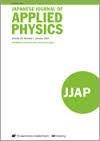利用感应热等离子体合成三元氮化钛铌纳米粒子
IF 1.8
4区 物理与天体物理
Q3 PHYSICS, APPLIED
引用次数: 0
摘要
利用感应热等离子体制备了高纯度三元氮化钛铌纳米粒子。金属钛粉和铌粉为原材料。氨气作为淬火气体从底部进入等离子体设备。纳米粒子以立方岩盐结构结晶,晶体空间群为 Fm-3m。所有纳米颗粒的形态相似。所有样品的平均粒度约为 10-14 纳米。元素 Ti、Nb 和 N 几乎均匀地分布在纳米颗粒中。通过研究成核温度和热力学分析,对形成机制进行了研究。三元氮化钛铌纳米粒子通过成核、凝结和氮化反应凝结迅速形成。事实证明,感应热等离子体是合成三元氮化钛铌纳米粒子的高效方法。本文章由计算机程序翻译,如有差异,请以英文原文为准。
Synthesis of ternary titanium–niobium nitride nanoparticles by induction thermal plasma
High-purity ternary titanium–niobium nitride nanoparticles were prepared by an induction thermal plasma. Metallic Ti and Nb powders served as raw materials. Molar fractions of Nb/(Ti+Nb) were set at various levels including 0, 0.25, 0.5, 0.75, and 1. Ammonia was introduced from the bottom into the plasma equipment as a quench gas. Nanoparticles crystallized in a cubic rock salt structure in the crystallographic space group Fm -3m . All nanoparticles exhibited similar morphology. The average particle size across all samples is approximately 10–14 nm. Elements Ti, Nb, and N are almost uniformly distributed in the nanoparticles. Investigations into the formation mechanism were conducted by examining nucleation temperature and thermodynamic analysis. Ternary titanium–niobium nitride nanoparticles form rapidly through nucleation, condensation, and coagulation with a nitridation reaction. Induction thermal plasma proves to be a highly efficient method for synthesizing ternary titanium–niobium nitride nanoparticles.
求助全文
通过发布文献求助,成功后即可免费获取论文全文。
去求助
来源期刊

Japanese Journal of Applied Physics
物理-物理:应用
CiteScore
3.00
自引率
26.70%
发文量
818
审稿时长
3.5 months
期刊介绍:
The Japanese Journal of Applied Physics (JJAP) is an international journal for the advancement and dissemination of knowledge in all fields of applied physics. JJAP is a sister journal of the Applied Physics Express (APEX) and is published by IOP Publishing Ltd on behalf of the Japan Society of Applied Physics (JSAP).
JJAP publishes articles that significantly contribute to the advancements in the applications of physical principles as well as in the understanding of physics in view of particular applications in mind. Subjects covered by JJAP include the following fields:
• Semiconductors, dielectrics, and organic materials
• Photonics, quantum electronics, optics, and spectroscopy
• Spintronics, superconductivity, and strongly correlated materials
• Device physics including quantum information processing
• Physics-based circuits and systems
• Nanoscale science and technology
• Crystal growth, surfaces, interfaces, thin films, and bulk materials
• Plasmas, applied atomic and molecular physics, and applied nuclear physics
• Device processing, fabrication and measurement technologies, and instrumentation
• Cross-disciplinary areas such as bioelectronics/photonics, biosensing, environmental/energy technologies, and MEMS
 求助内容:
求助内容: 应助结果提醒方式:
应助结果提醒方式:


